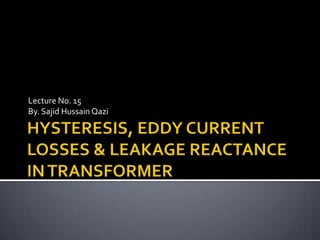
Lec 8 hysteresis-_eddy_current_losses_in_transformer
- 1. Lecture No. 15 By. Sajid Hussain Qazi
- 2. Physical explanation of Hysteresis loss ▪ The magnetic core of transformer is made of ′Cold Rolled Grain Oriented Silicon Steel′. ▪ Steel is very good ferromagnetic material. This kind of materials are very sensitive to be magnetized. That means whenever magnetic flux passes through ,it will behave like magnet. ▪ Ferromagnetic substances have numbers of domains in their structure.
- 3. Domain are very small region in the material structure, where all the dipoles are paralleled to same direction. In other words, the domains are like small small permanent magnet situated randomly in the structure of substance. These domains are arranged inside the material structure in such a random manner, that net resultant magnetic field of the said material is zero. Whenever external magnetic field or mmf is is applied to that substance, these randomly directed domains are arranged themselves in parallel to the axis of applied mmf. After removing this external mmf, maximum numbers of domains again come to random positions, but some few of them still remain in their changed position.
- 4. Because of these unchanged domains the substance becomes slightly magnetized permanently. This magnetism is called " Spontaneous Magnetism". To neutralize this magnetism some opposite mmf is required to be applied. The mmf applied in the transformer core is alternating. For every cycle, due to this domain reversal there will be extra work done. For this reason, there will be a consumption of electrical energy which is known as Hysteresis loss of transformer.
- 5. In transformer we supply alternating current in the primary, this alternating current produces alternating magnetizing flux in the core and as this flux links with secondary winding there will be induced voltage in secondary, resulting current to flow through the load connected with it. Some of the alternating fluxes of transformer may also link with other conducting parts like steel core or iron body of transformer etc. As alternating flux links with these parts of transformer, there would be an locally induced emf.
- 6. Due to these emfs there would be currents which will circulate locally at that parts of the transformer. These circulating current will not contribute in output of the transformer and dissipated as heat. This type of energy loss is called EDDY CURRENT LOSS OF TRANSFORMER.
- 7. All the flux in transformer will not be able to link with both the primary and secondary windings. A small portion of flux will link either winding but not both. This portion of flux is called leakage flux. Due to this leakage flux in transformer there will be a self - reactance in the concerned winding. This self-reactance of transformer is alternatively known as leakage reactance of transformer. This self - reactance associated with resistance of transformer is impedance. Due to this impedance of transformer there will be voltage drops in both primary and secondary transformer windings.
- 8. Generally both primary and secondary windings of electrical power transformer are made of copper. Copper is very good conductor of current but not a super conductor. Actually super conductor are not available. So both windings will have some resistance. This internal resistance of both primary and secondary windings are collectively known as resistance of transformer.
- 9. As we said, both primary and secondary windings will have resistance and leakage reactance. These resistance and reactance will be in combination is nothing but impedance of transformer. If R1 & R2 and X1 & X2 are primary & secondary resistance & leakage reactance of transformer respectively, then Z1 & Z2impedance of primary & secondary windings are respectively.
- 10. Z1 = R1 + jX1 Z2 = R2 + jX2 The Impedance of transformer plays a vital role during parallel operation of transformer
- 11. In ideal transformer all the flux will link with both primary and secondary winding but in reality it is impossible to link all the flux in transformer with both primary and secondary windings. Although maximum flux will link with both winding through the core of transformer but still there will be a small amount of flux which will link either winding not both. This flux is called leakage flux which will pass through the winding insulation and transformer insulating oil instead of passing through core.
- 12. Due to this leakage flux in transformer, both primary and secondary winding have leakage reactance. These reactance of transformer is nothing but leakage reactance of transformer. This phenomena in transformer is known as Magnetic Leakage. Voltage drops in the windings occur due to impedance of transformer.
- 13. Impedance is combination of resistance and leakage reactance of transformer. If we apply voltage V1 across primary of transformer, there will be a component I1X1 to balance primary self induced emf due to primary leakage reactance. (Here, X1 is primary leakage reactance). Now if we also consider voltage drop due to primary resistance of transformer,
- 14. then voltage equation of a transformer can easily be written as, V1 = E1 + I1(R1 + jX1) ⇒ V1 = E1 + I1R1 + jI1X1 Similarly for secondary leakage reactance, the voltage equation of secondary side is, V2 = E2 - I2(R2 + jX2) ⇒ V2 = E2 - I2R2 − jI2X2
